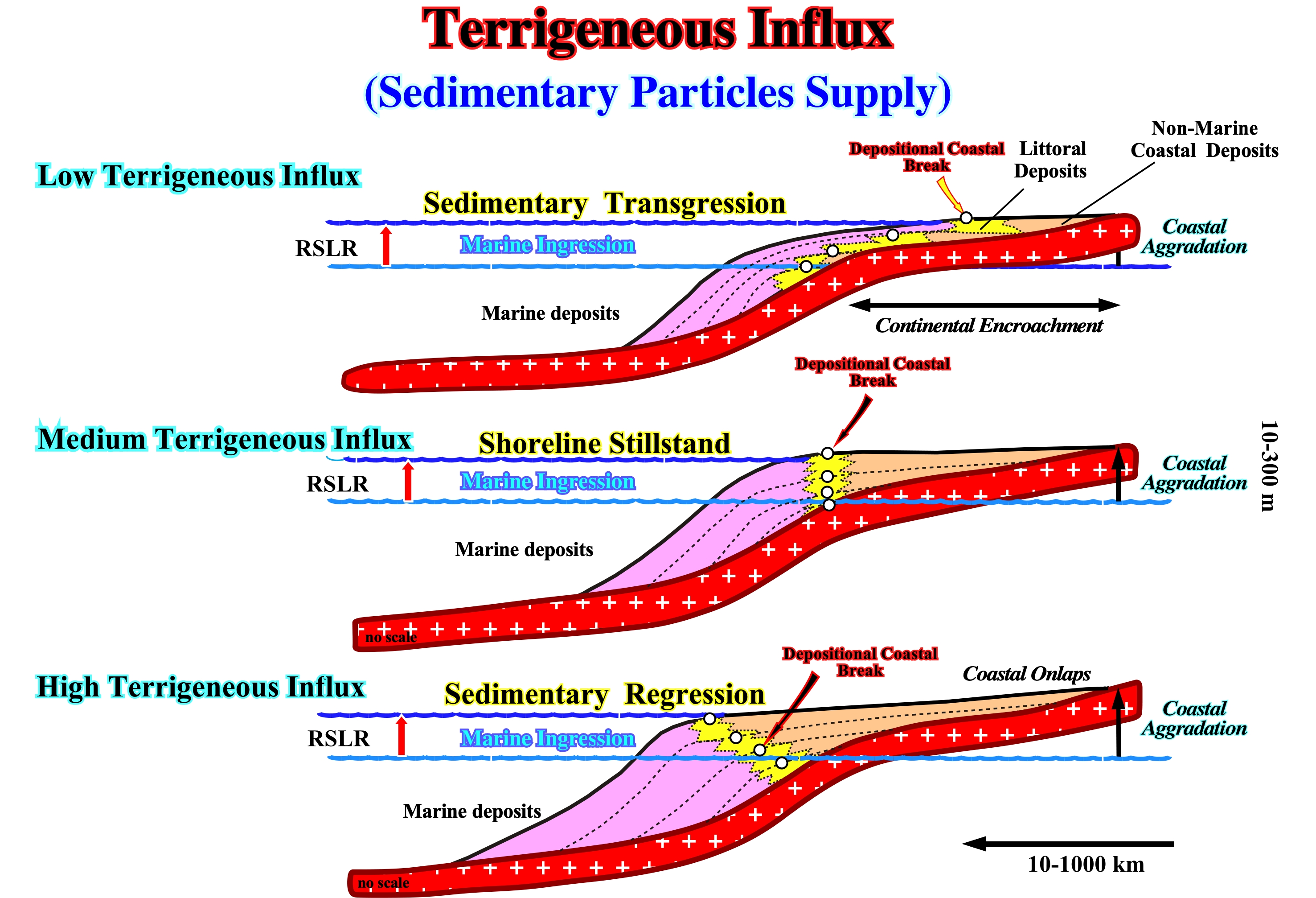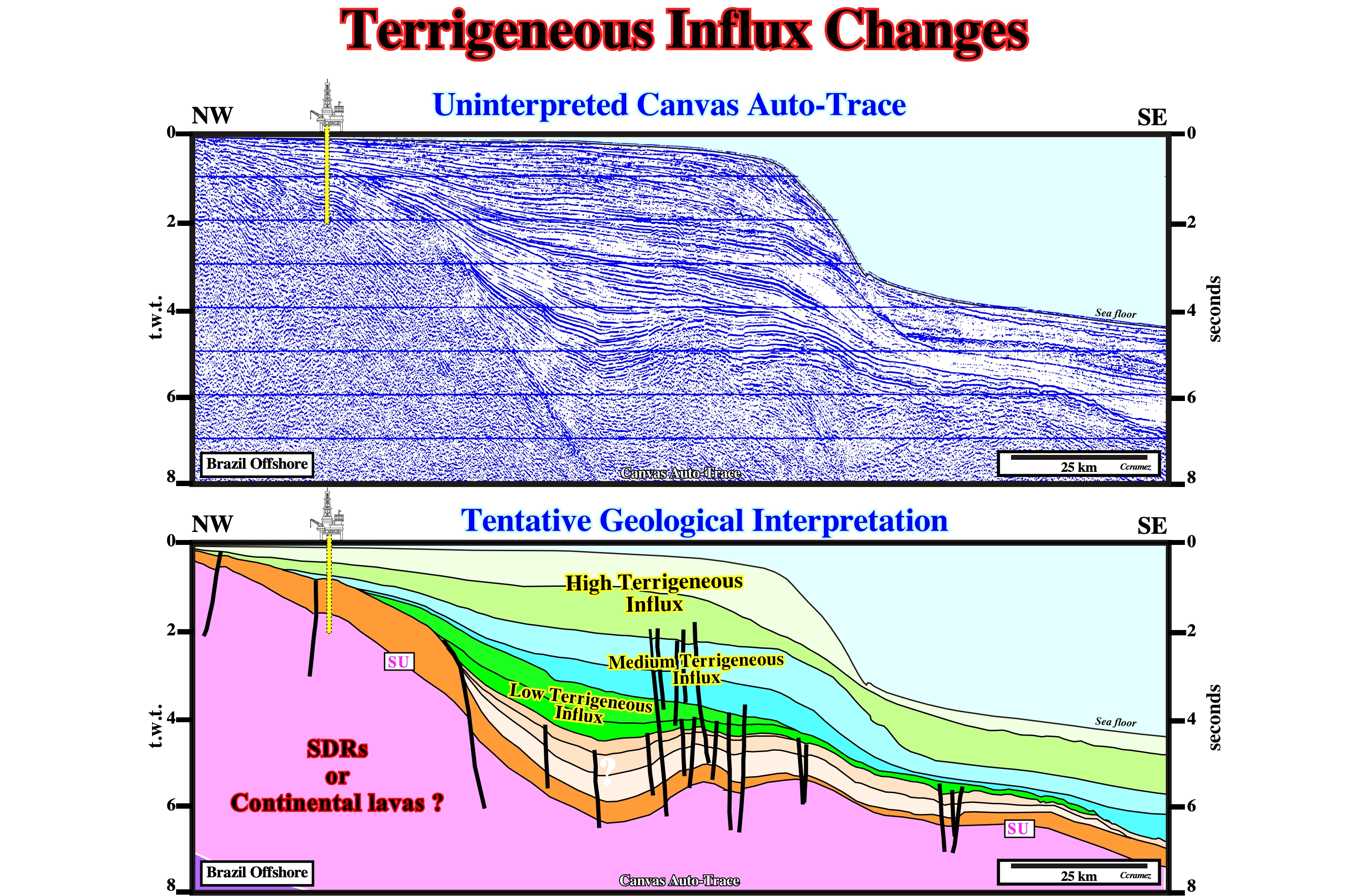

Terrigeneous Influx
The amount of sedimentary particles, i.e., the terrigeneous influx or sedimentary particles supply is related, mainly, to tectonic, eustatism (absolute sea level changes) and climate:
- Compressional tectonic regimes induce lifting, which increase the available amount of sediment to deposition ;
- Relative sea level falls disrupt the equilibrium profile of the rivers, which increases the amount of sedimentary particles ;
- Since rivers' equilibrium profiles are disrupted, they are forced to incise their beds to reach new provisional equilibrium profiles ;
- Climate is, also, an important factor not only in carbonate deposition, but in the deposition of sandy-clay sediments as well.

Figure 076- A sedimentary regression (seaward displacement of the shoreline or depositional coastal break) and a sedimentary transgression (landward displacement of the shoreline and coastal deposits) are, mainly, dependent on marine ingressions (relative sea level rises) and terrigeneous influx. Generally, when the terrigeneous influx is important, there is a seaward displacement of coastal deposits (progradational geometry). In particular cases, the terrigeneous influx can balance the relative sea level rise (medium terrigeneous influx) and so the coastline is not displaced (stationary shoreline). When the terrigeneous influx is weak, the coastline and coastal deposits are displaced continentward (retrogradational geometry). All this means that for the same relative sea level rise, in a certain place, there may be a sedimentary regression and in another a sedimentary transgression function of the terrigeneous influx.
In a basin, the terrigeneous influx changes in spatial and temporally. The changes of the sedimentary particle supply make global and regional correlations very difficult. As illustrated in the figure above, taking into account the terrigeneous influx, three different geological situations can be considered for the same marine ingressions: (i) Low Terrigeneous Influx ; (ii) Medium Terrigeneous Influx and (iii) High Terrigeneous Influx. In our example (Figure 076) the marine ingression is the resulting of four relative sea level rise increments without any relative sea level fall between them. Each increment, which creates of space for the sediments, is followed by a period of stability of the relative sea level during which deposition take place.
(i) In the first geological situation (Figure 076), during the first sea level rise increment (1st step of the marine ingression), the shoreline (roughly the depositional coastal break) is displaced lanward, creating a small ravinement surface on the previous topographic surface and a modest continental platform under a given water-depth. A period of stability of the relative sea level rise follows 1st marine increment, during which deposition resumes as the depositional coastal break is displaced seaward. The next relative sea level rise (2nd step of the marine ingression), more important than the previous one, displaces, again, the shoreline landward with formation of a ravinement surface and a larger continental platform than previously. During the period of stability of the relative sea level, deposition resumes, again, as the shoreline is displaced seaward. However, the shoreline does not reach the position it had before the 2nd step of the marine ingression, because the terrigeneous influx became insufficient due to extent increasing of the continental platform. A new relative sea level rise increment (more important than the precedent, since the relative sea level rise is in acceleration) displaces, again, the shoreline landward creating a new ravinement surface with a substantial increasing of the extension of the continental platform (shelf). The shoreline moves, again, seaward, during the period of stability of the relative sea level, deposing a new sequence paracycle. However, the shoreline do not reach the position it had before 3rd marine ingression increment. This mechanism, i.e., increasingly important marine ingression steps and increasingly smaller sedimentary regressions, continues until the relative sea level rise become in deceleration, i.e., less important than the previous one. All other factors equal, such a change in the rate of the sea level rise, modifies the terrigeneous influx, since the area exposed to the erosive agents becomes bigger (smaller shelf). Globally, the retrogradational displacement of the shoreline (sedimentary transgression) can be explained by this mechanism, which produces a progressively smaller terrigeneous influx.
(ii) In the second situation (Figure 076), in which the terrigeneous influx is big enough to counterbalanced the relative sea level rise, the movement of the shoreline corresponds just to an upbuilding, i.e., there no seaward or landward movement of the shoreline. This situation is the result of a more or less constant relative sea level rise increments (no significant extension change of the area subjected to the erosive agents). In other words, the importance of the marine ingression steps and the sedimentary regression, (deposited during the stability periods of the relative sea level between the marine ingression) is more or less constant.

Figure 077- On this tentative geological interpretation of a Canvas auto-trace of the Brazil offshore (Pelotas geographic basin), in the upper part of the continental margin package, the geometrical relationships and the internal configuration of the seismic intervals allow geoscientists to conjecture three sedimentary packages characterized by a quite different terrigeneous influx, i.e., low, middle and terrigeneous influx. In fact, in a low terrigeneous influx seismic interval, globally, the depositional coastal break (roughly the shoreline) shows a retrogradational movement, while in a high terrigeneous influx interval the successive depositional coastal breaks show a typical progradational displacement. In the medium terrigeneous influx, which counterbalance the relative sea level rise (successive marine ingressions), the movement of the depositional coastal break is mainly characterized by upbuilding.
(iii) In the third situation (Figure 076), the marine ingressions are increasingly smaller (relative sea level in deceleration) and the sedimentary regressions increasingly important. The terrigeneous influx, i.e., the supply of sedimentary particles, is increasingly higher, because the area subjected to the erosive agents is, each time, larger (all other geological factors are considered constant). As in the other situation the depositional mechanism is the same: a) Marine ingression increasing the shelfal accommodation followed by b) a stability period of the relative sea level, during which deposition occurs until a new marine ingression, etc., This geological mechanism changes when the relative sea level falls, which creates, generally, an unconformity if the sea level is put under the basin edge (lowstand geological situation).